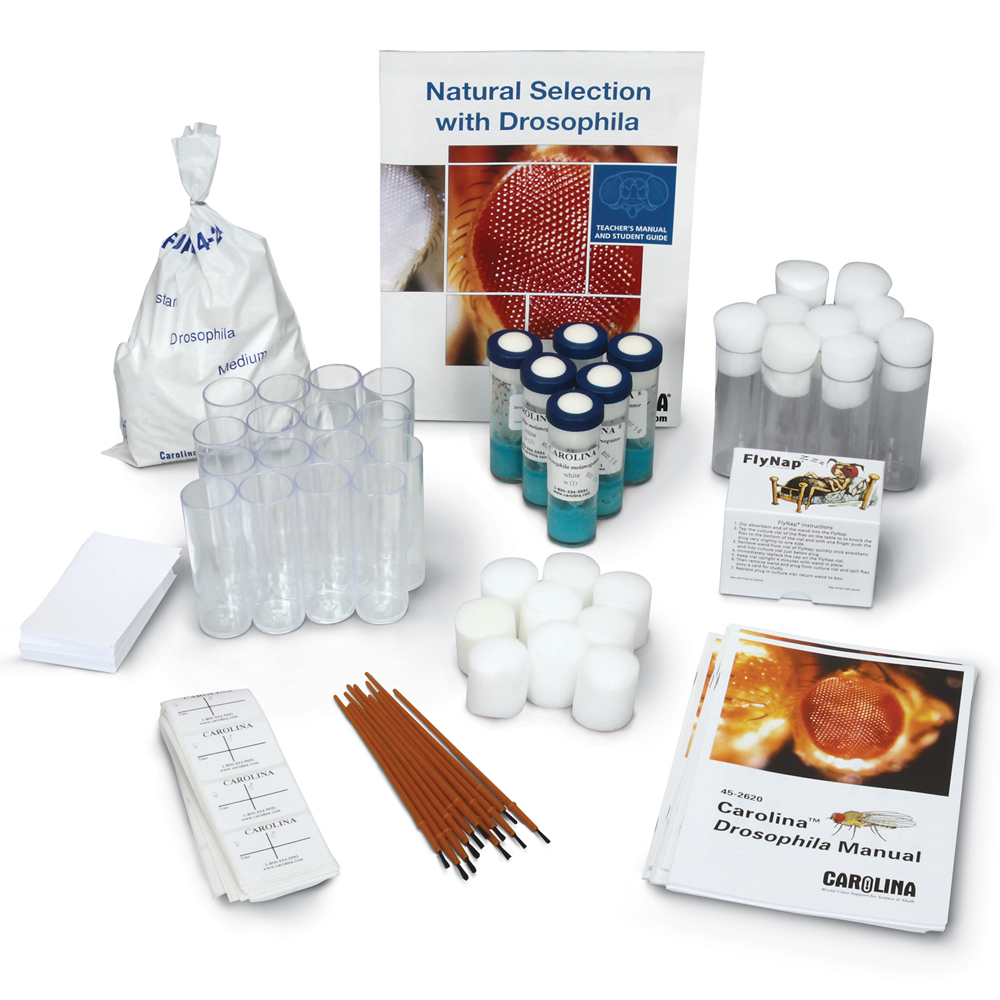Carolina LabSheets™
Overview
In this lab students compare phenotypes of mutant Drosophila to wild type. The activity is intended as a student’s first experience working with Drosophila. It may serve as a stand-alone activity or as a pre-lab to our Introductory Genetics with Drosophila LabSheet
Needed Materials
- Wild-type Drosophila culture (172100), 1 per team of four to six students
- A selection of Drosophila mutant cultures. Although any may be used, we recommend the following selection, which provides both good variety and easy recognition:
- 172220 white - white eye color, chromosome 1 mutant (sex-linked)
- 172320 apterous - wingless, chromosome 2 mutant
- 172460 vestigial - greatly reduced wings, chromosome 2 mutant
- 172500 ebony - black body color, chromosome 3 mutant
- 172575 sepia - dark brown eye color, chromosome 3 mutant
- 172600 Wrinkled - wrinkled wings (dominant), chromosome 3 mutant
- FlyNap® Kit (173010)
- Drosophila sorting brushes (173094)
- index cards or petri dish lids
- Carolina™ Drosophila Manual (452620)
- stereomicroscopes (preferred) or hand lenses
Safety
Ensure that students understand and adhere to safe laboratory practices when performing any activity in the classroom or lab. Demonstrate the protocol for correctly using the instruments and materials necessary to complete the activities, and emphasize the importance of proper usage. Use personal protective equipment such as safety glasses or goggles, gloves, and aprons when appropriate. Model proper laboratory safety practices for your students and require them to adhere to all laboratory safety rules.
Procedures
Have students work individually or in groups of 2–4.
When your cultures arrive, open the package immediately and inspect the cultures to verify that they have arrived in good condition.
Each culture will produce approximately 100 flies over a 10-day period and will serve 6–8 groups.
A small wide-mouthed bottle is included in each FlyNap® kit for use as a morgue. Half fill it with alcohol or a detergent–water mix.
Before the lab, anesthetize the flies and place them on index cards or petri dishes that are marked for identification (wild type, 1, 2, 3, etc.) Do not identify the mutants by their official names. Not only are the names themselves descriptive, but knowing the names would allow students to look up the information rather than rely on their own observations.
Place four or five flies on each card or dish. Because students are to compare each of the mutants to wild type, there should be a sample of wild-type flies for each group. Teams will share the mutants. It takes about 2 hours for the flies to recover from FlyNap®, allowing plenty of time for the students to complete the activity.
At the end of the lab, collect the flies and dispose of them in the morgue. The flies may instead be re-anesthetized for use in a later lab.
Answer Key to Questions Asked on the Student LabSheet
The following table is filled in as if a class used the mutant cultures recommended in the Needed Materials. If you use different cultures, these answers will not apply.
Phenotype Table

Obtain an index card or petri dish with mutant flies. Fill in the Phenotype Table for the mutant. Circle the phenotype that differs from that of the wild-type fly.
Choose one of the mutations for further study. How could you determine whether the mutation is inherited through a dominant or a recessive allele? Briefly explain how crossing a mutant fly with a wild-type fly would help you answer this question.
If the mutant is crossed with a wild-type fly (which is homozygous), the phenotype that is expressed in the offspring results from the action of a dominant allele. Note: If the gene locus is sex-linked, the phenotypes of male and female offspring will differ.
How would the results of this cross demonstrate the difference between phenotype and genotype?
The offspring inherits a dominant allele from one parent and a recessive allele from the other and is heterozygous, but it has the phenotype (appearance) of only the parent that contributed the dominant allele. It differs from that parent in that it can transmit the recessive allele to its offspring.
RELATED PRODUCTS
About The Author
Carolina Staff
Carolina is teamed with teachers and continually provides valuable resources–articles, activities, and how-to videos–to help teachers in their classroom.


